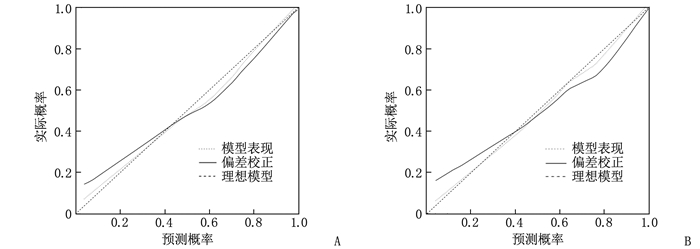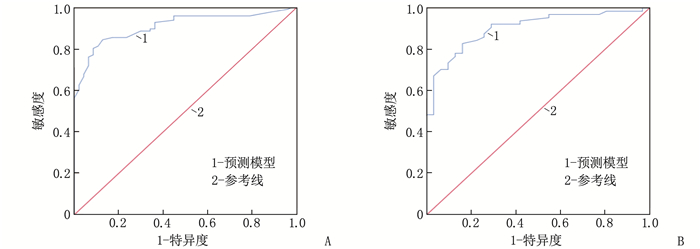Construction of nomogram predictive model for mental state in patients after retinal detachment reduction surgery and its verification
-
摘要:目的
基于视网膜脱离复位术后患者心理状态的影响因素构建列线图预测模型, 并验证模型的预测效能。
方法收集238例视网膜脱离复位术患者的临床资料,按照6∶4比例将纳入对象分为建模组143例和验证组95例; 采用焦虑自评量表(SAS)、抑郁自评量表(SDS)评估患者的不良心理状态; 采用单因素和多因素Logistic回归分析明确视网膜脱离复位术后患者心理状态的影响因素,并建立风险预测模型; 绘制受试者工作特征(ROC)曲线、校准曲线评估模型的预测效能,并进行Hosmer-Lemeshow拟合优度检验。
结果建模组143例患者中, 96例(67.13%)出现负性心理状态; 单因素分析结果显示,年龄、经济压力、合并慢性病、失眠、视网膜脱离距手术时间、另眼视力情况均为视网膜脱离复位术后患者心理状态的影响因素(P < 0.05); 多因素Logistic回归分析结果显示,年龄 < 55岁(OR=3.214)、有经济压力(OR=3.328)、合并慢性病(OR=3.631)、失眠(OR=7.886)、视网膜脱离距手术时间>7 d(OR=5.897)、另眼存在视力缺陷(OR=6.133)均为患者负性心理状态的独立危险因素(P < 0.05)。Hosmer-Lemeshow拟合优度检验结果显示,基于影响因素构建的列线图模型在建模组(χ2=6.470, P=0.595)、验证组(χ2=6.343, P=0.535)中均具有良好的校准度; 校准曲线显示, 列线图模型在建模组和验证组中预测的负性心理状态发生风险与实际发生风险具有良好一致性; ROC曲线显示,列线图模型在建模组、验证组中预测负性心理状态的曲线下面积分别为0.909(95%CI: 0.849~0.951)、0.902(95%CI: 0.824~0.954)。
结论根据视网膜脱离复位术后患者心理状态的影响因素(年龄、经济压力、合并慢性病、失眠、视网膜脱离距手术时间、另眼视力情况)构建的列线图预测模型区分度、有效性均良好,可为此类患者临床治疗方案的选择提供参考依据。
Abstract:ObjectiveTo construct a predictive model for the psychological state of patients after retinal detachment reduction, and to verify the predictive effect of the model.
MethodsThe clinical data of 238 patients who underwent retinal detachment reduction were collected, the included subjects were divided into modeling group (143 cases) and validation group (95 cases) at a ratio of 6∶4; Self-rating Anxiety Scale (SAS) and Self-rating Depression Scale (SDS) were used to evaluate the poor psychological state of patients; univariate and multivariate Logistic regression analysis were used to analyze the risk factors affecting the psychological state of patients after retinal detachment, and a risk prediction model was established. Receiver operating characteristic (ROC) curve and calibration curve were drawn to evaluate the predictive effectiveness of the model, and Hosmer-Lemeshow goodness-of-fit test was performed.
ResultsIn 143 patients in the modeling group, 96 patients(67.13%) with retinal detachment had negative psychological state; the results of univariate analysis showed that age, economic pressure, complicating with chronic diseases, insomnia, time since preoperative retinal detachment, and visual acuity of the other eye were the influencing factors of the psychological state of patients after retinal detachment (P < 0.05); multivariate Logistic regression analysis showed that age < 55 years old (OR=3.214), financial stress (OR=3.328), complicating with chronic disease (OR=3.631), insomnia (OR=7.886), time since preoperative retinal detachment (>7 d) (OR=5.897) and visual impairment in the other eye (OR=6.133) were risk factors for negative psychology (P < 0.05). The results of the Hosmer-Lemeshow goodness of fit test showed that established model based on risk factors had a good degree of calibration in both modeling group(χ2=6.470, P=0.595)and validation group(χ2=6.343, P=0.535); the calibration curves of the modeling group and the validation group showed that the risk of negative emotions predicted by the model was in good agreement with the risk that actually occurred; the results of the ROC curve showed that the area under the curve for predicting the occurrence of negative emotions in the modeling group and the validation group was 0.909 (95%CI, 0.849 to 0.951) and 0.902 (95%CI, 0.824 to 0.954), respectively.
ConclusionBased on the influencing factors of psychological state in patients after retinal detachment repositioning (age, economic pressure, complicating with chronic diseases, insomnia, time from retinal detachment to surgery, visual acuity of the other eye), the nomogram prediction model has better differentiation, effectiveness, which can provide a reference for the selection of clinical treatment for such patients.
-
Keywords:
- retinal detachment reduction /
- nomogram model /
- eyesight /
- anxiety /
- depression /
- insomnia
-
-
表 1 建模组和验证组患者基线特征比较[n(%)]
因素 分类 建模组(n=143) 验证组(n=95) χ2 P 年龄 ≥55岁 85(59.44) 48(50.53) 1.840 0.175 < 55岁 58(40.56) 47(49.47) 性别 男 83(58.04) 50(52.63) 0.678 0.595 女 60(41.96) 45(47.37) 婚姻状况 已婚 80(55.94) 50(52.63) 1.567 0.457 未婚 35(24.48) 20(21.05) 离异/丧偶 28(19.58) 25(26.32) 文化程度 高中及以下 43(30.07) 24(25.26) 0.193 0.627 大专 70(48.95) 47(49.47) 本科及以上 30(20.98) 24(25.26) 经济压力 有 51(35.66) 38(40.00) 0.458 0.498 无 92(64.34) 57(60.00) 合并慢性病 是 50(34.97) 28(29.47) 0.986 0.321 否 93(65.03) 67(70.53) 性格 内向 56(39.16) 31(32.63) 1.049 0.306 外向 87(60.84) 64(67.37) 居住类型 独居 10(6.99) 8(8.42) 0.167 0.683 与家人同住 133(93.01) 87(91.58) 视网膜脱离范围 全脱离 72(50.35) 43(45.26) 0.591 0.442 局限性 71(49.65) 52(54.74) 失眠 有 78(54.55) 45(47.37) 1.177 0.278 无 65(45.45) 50(52.63) 术眼视力 < 0.1 45(31.47) 21(22.11) 2.497 0.114 ≥0.1 98(68.53) 74(77.89) 视网膜脱离距手术时间 < 3 d 24(16.78) 19(20.00) 0.480 0.787 3~7 d 57(39.86) 38(40.00) > 7 d 62(43.36) 38(40.00) 患眼疾病状态 首发 111(77.62) 67(70.53) 1.524 0.217 复发 32(22.38) 28(29.47) 疾病类型 孔源性 68(47.55) 40(42.11) 5.432 0.066 渗出性 57(39.86) 32(33.68) 牵拉性 18(12.59) 23(24.21) 另眼视力情况 视力正常 73(51.05) 42(44.21) 1.069 0.301 存在视力缺陷 70(48.95) 53(55.79) 表 2 建模组患者心理状态的单因素分析[n(%)]
因素 分类 n 建模组(n=143) χ2 P 负性心理组(n=96) 正常心理组(n=47) 年龄 ≥55岁 85 65(67.71) 20(42.55) 8.282 0.004 < 55岁 58 31(32.29) 27(57.45) 性别 男 83 55(57.29) 28(59.57) 0.068 0.795 女 60 41(42.71) 19(40.43) 婚姻状况 已婚 80 54(56.25) 26(55.32) 0.043 0.979 未婚 35 23(23.96) 12(25.53) 离异 28 19(17.79) 9(19.15) 文化程度 高中及以下 43 29(30.21) 14(29.79) 0.177 0.915 大专 70 46(47.92) 24(51.06) 本科及以上 30 21(21.87) 9(19.15) 经济压力 有 51 40(41.67) 11(23.40) 4.586 0.032 无 92 56(58.33) 36(76.60) 合并慢性病 是 50 41(42.71) 9(19.15) 7.702 0.006 否 93 55(57.29) 38(80.85) 性格 内向 56 38(39.58) 18(38.30) 0.022 0.882 外向 87 58(60.42) 29(61.70) 居住类型 独居 10 4(4.17) 6(12.77) 3.587 0.058 与家人同住 133 92(95.83) 41(87.23) 视网膜脱离范围 全脱离 72 51(53.12) 21(44.68) 0.900 0.343 局限性 71 45(46.88) 26(55.32) 失眠 有 78 65(67.71) 13(27.66) 20.412 < 0.001 无 65 31(32.29) 34(72.34) 术眼视力 < 0.1 45 30(31.25) 15(31.91) 0.006 0.936 ≥0.1 98 66(68.75) 32(68.09) 视网膜脱离距手术时间 < 3 d 24 6(6.25) 18(38.30) 7.383 0.025 3~7 d 57 35(36.46) 22(46.81) > 7 d 62 55(57.29) 7(14.89) 患眼疾病状态 首发 111 70(72.91) 41(87.23) 3.724 0.054 复发 32 26(27.08) 6(12.77) 疾病类型 孔源性 68 46(47.92) 22(46.81) 0.347 0.841 渗出性 57 37(38.54) 20(42.55) 牵拉性 18 13(13.54) 5(10.64) 另眼视力情况 视力正常 73 38(39.58) 35(74.47) 15.366 < 0.001 存在视力缺陷 70 58(60.42) 12(25.53) 表 3 变量赋值方式
自变量 赋值方式 年龄 < 55岁=1, ≥55岁=0 经济压力 无=0, 有=1 合并慢性病 无=0, 有=1 失眠 无=0, 有=1 视网膜脱离距手术时间 < 3 d=0, 3~7 d=1, > 7 d=2 另眼视力情况 视力正常=0, 存在视力缺陷=1 表 4 视网膜脱离复位术后患者负性心理状态的多因素Logistic回归分析
因素 B SE Wald P OR 95% CI 年龄 1.167 0.473 6.092 0.014 3.214 1.272~8.121 经济压力 1.202 0.536 5.030 0.025 3.328 1.164~9.516 合并慢性病 1.289 0.534 5.829 0.016 3.631 1.275~10.342 失眠 2.065 0.495 17.385 < 0.001 7.886 2.987~20.817 视网膜脱离距手术时间 > 7 d 1.774 0.755 5.524 0.019 5.897 1.343~25.895 另眼视力情况 1.814 0.509 12.693 < 0.001 6.133 2.261~16.663 常量 -3.410 0.864 15.566 < 0.001 0.033 — -
[1] 柏春芹. 视网膜脱离术后患者心理痛苦状况及其影响因素分析[J]. 世界最新医学信息文摘, 2020, 20(90): 133-134. doi: 10.3969/j.issn.1671-3141.2020.90.065 [2] 蔡华敏. 综合护理干预对视网膜脱落患者心理状态的临床意义研究[J]. 中国实用医药, 2019, 14(10): 134-135. https://www.cnki.com.cn/Article/CJFDTOTAL-ZSSA201910073.htm [3] 肖晓艳, 杨会娟. 原发性闭角型青光眼术后患者心理状况调查及其影响因素分析[J]. 河南医学研究, 2021, 30(24): 4463-4466. doi: 10.3969/j.issn.1004-437X.2021.24.013 [4] 于丽菲, 姜丽, 荆艳莉. 认知行为干预结合系统护理对原发性闭角型青光眼患者术后遵医行为及心理状态的影响[J]. 中国医学创新, 2020, 17(4): 97-101. https://www.cnki.com.cn/Article/CJFDTOTAL-ZYCX202004025.htm [5] 陶明, 高静芳. 修订焦虑自评量表(SAS-CR)的信度及效度[J]. 中国神经精神疾病杂志, 1994, 20(5): 301-303. https://www.cnki.com.cn/Article/CJFDTOTAL-ZSJJ405.022.htm [6] 段泉泉, 胜利. 焦虑及抑郁自评量表的临床效度[J]. 中国心理卫生杂志, 2012, 26(9): 676-679. https://www.cnki.com.cn/Article/CJFDTOTAL-ZXWS201209007.htm [7] 刘家琦, 李凤鸣. 实用眼科学[M]. 3版. 北京: 人民卫生出版社, 2010: 480-483. [8] 徐云芳, 梁荣斌, 张丽娟, 等. 视网膜脱离患者脑白质纤维束的异常变化[J]. 眼科新进展, 2021, 41(6): 545-548. https://www.cnki.com.cn/Article/CJFDTOTAL-XKJZ202106010.htm [9] 陈伟, 陈国良, 郑景华, 等. 青光眼与白内障患者疾病不确定感、焦虑和抑郁状况及其影响因素分析[J]. 解放军医学院学报, 2019, 40(12): 1160-1164. doi: 10.3969/j.issn.2095-5227.2019.12.012 [10] 刘延彬, 胡瑞丽, 李燕萍, 等. 分化型甲状腺癌术后患者不良心理状态的影响因素调查及其干预对策[J]. 河北医科大学学报, 2021, 42(11): 1302-1306. doi: 10.3969/j.issn.1007-3205.2021.11.013 [11] 赵清永, 杨少娟, 李玲玉. 探讨颅脑外伤手术后康复期患者的心理状态及其影响因素[J]. 心理月刊, 2022, 17(13): 41-43. https://www.cnki.com.cn/Article/CJFDTOTAL-XLYK202213012.htm [12] 邹舒倩, 詹丽君, 黎葵金, 等. 预测宫颈癌术后发生抑郁风险因素的列线图模型建立[J]. 现代医药卫生, 2021, 37(21): 3607-3610, 3615. https://www.cnki.com.cn/Article/CJFDTOTAL-XYWS202121004.htm [13] 陈娟, 谢军, 孙媛媛, 等. 老年衰弱患者焦虑、抑郁、生活质量状况的分析[J]. 实用临床医药杂志, 2019, 23(4): 73-77. doi: 10.7619/jcmp.201904022 [14] 刘思源, 黎红华, 骆文静, 等. 高血压患者失眠与焦虑抑郁的共病临床分析[J]. 神经损伤与功能重建, 2021, 16(2): 114-115, 120. https://www.cnki.com.cn/Article/CJFDTOTAL-GWKF202102017.htm [15] 汪紫妍, 诸国华, 华琦. 高血压患者抑郁焦虑共病的研究进展[J]. 中华保健医学杂志, 2021, 23(3): 307-310. https://www.cnki.com.cn/Article/CJFDTOTAL-JFJB202103031.htm [16] 潘佳妮. 心理护理对脑梗死患者心理状态及生活质量的影响[J]. 实用临床医药杂志, 2018, 22(12): 15-18. doi: 10.7619/jcmp.201812005 [17] 杨柳, 薛茗予, 薛志玲, 等. 原发性青光眼患者术后心理状态及影响因素研究[J]. 中华眼外伤职业眼病杂志, 2020, 42(7): 521-526. https://www.cnki.com.cn/Article/CJFDTOTAL-ZYCX202004025.htm [18] 焦亮亮, 朱文魁, 郭浩轶. 老年原发性青光眼患者合并焦虑及抑郁情绪的影响因素[J]. 国际精神病学杂志, 2020, 47(4): 784-787. https://www.cnki.com.cn/Article/CJFDTOTAL-GWYJ202004041.htm [19] 王槐英, 李源, 任晓丹, 等. 视网膜脱落术后患者心理痛苦状况及其影响因素分析[J]. 现代临床护理, 2018, 17(4): 7-12. https://www.cnki.com.cn/Article/CJFDTOTAL-XDLH201804004.htm





 下载:
下载:


 苏公网安备 32100302010246号
苏公网安备 32100302010246号
